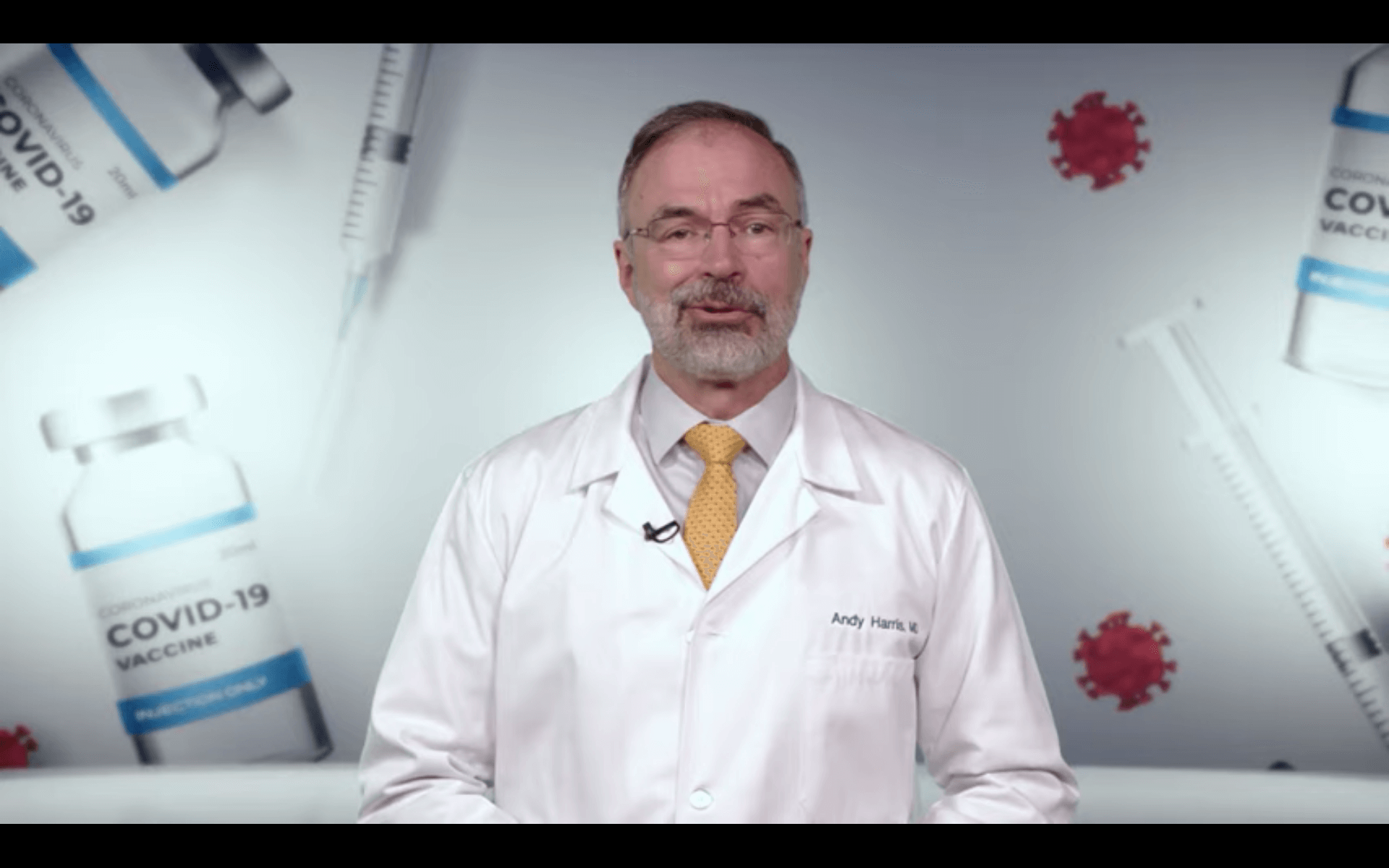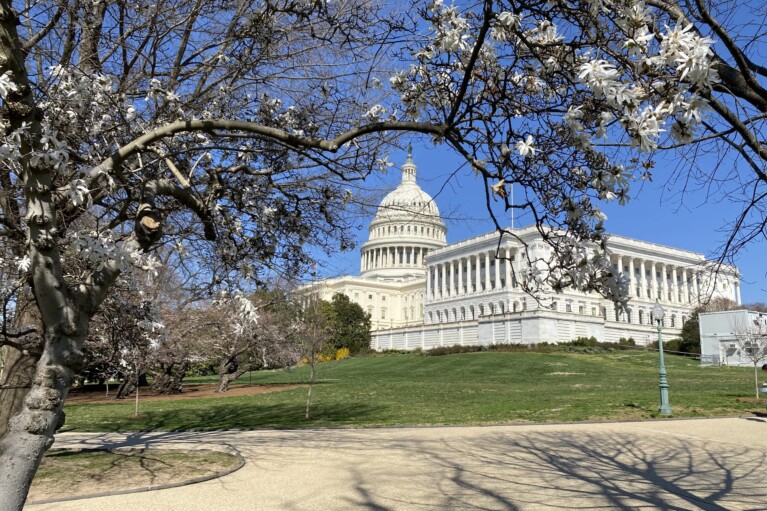Mirroring National Trend, Maryland’s “Trump Counties” Are Slower to Get Vaccinated

In a recently-produced video circulating on social media, Rep. Andrew P. Harris (R-Md.) urges people to get vaccinated against COVID-19.
Joined by nine other Republican physician-legislators, Harris tells viewers that the development of safe and effective vaccines provides the country “a clear path to the eradication of the pandemic.”
“The FDA did not skip any steps,” he adds.
Rep. Larry Bucshon (R-Ind.) said getting vaccinated will bring an end to “the government’s restrictions on our freedoms.”
Harris — a Trump loyalist and an anesthesiologist — has drawn praise for appearing in the video and for posting photos of himself administering vaccines at clinics in his district.
The video’s message comes at a crucial time. With polls consistently showing that as many as 40% of Republicans don’t intend to get a shot, public health experts across the country are worried that herd immunity is at risk.
A Maryland Matters analysis found vaccination patterns in the state that mirror the nation’s.
The six least-vaccinated jurisdictions in Maryland — and nine of the bottom 12 — were won by Donald Trump in 2020.
Of the three jurisdictions carried by Democrat Joe Biden that have below-average vaccination rates — Baltimore City and Prince George’s and Charles counties — all are majority-Black.
At the top end of the spectrum, six of the eight most-vaccinated counties in Maryland were won by Biden.
For purposes of this analysis, Maryland Matters counted every resident who has had at least one dose of any of the vaccines being offered.
There are many factors that determine who gets vaccinated who doesn’t, health experts caution. For months, access to the vaccine has been limited, though appointments now are plentiful.
Many vaccine-seekers lacked the ability to spend hours online, prowling the Web for an appointment, nor did they have the flexible schedules needed to get to a vaccination site. Access to transportation has been another challenge.
The Maryland Department of Health and the state’s Vaccine Equity Task Force have spent many weeks trying to overcome these and other barriers, expanding distribution sites, bringing vaccines into under-served communities, working with faith and community groups, tailoring messages, enlisting family physicians and “trusted voices,” and more.
While those efforts have boosted the state’s vaccination rate overall and closed some of the gaps that set off alarm bells during the early months of the rollout, data confirm that African-Americans and Republicans are less likely to be vaccinated than non-Black Democrats and members of other racial groups.
“A lot of it has to do with your political ideology and who you’re listening to, where you get your facts from, and who you trust,” said Ed Singer, Carroll County’s chief health officer and head of the Maryland Association of County Health Officers. “Let’s be honest about it.”
Singer said vaccination rates in minority communities have risen as people observe friends and family members getting vaccinated without complication.
“When they saw that it was fine [and] nobody was having issues with it, it really helped,” he said.
Rep. Harris’s press secretary did not respond to a request for comment submitted last week. But Joshua M. Sharfstein, Vice Dean for Public Health Practice and Community Engagement at the Johns Hopkins Bloomberg School of Public Health, praised him for appearing in a pro-vaccination video.
“We shouldn’t overdo the politics of it in Maryland,” he said, “because we have a Republican governor and we have Republican legislators who are very supportive of vaccines.”
Vaccination advocates are fighting a daily battle against high-profile media personalities — Tucker Carlson of Fox and others — who have offered messaging that contradicts public-health guidance.
A focus group empaneled by pollster Frank Luntz found that GOP resistance to the vaccine remains entrenched, particularly among men.
Jerome Adams, a former U.S. surgeon general writing in his private capacity as a University of Virginia scholar, urged Trump to put his influence with the Republican base to good use.
“A lot of people who are reluctant to get the shot trust the former president,” Adams wrote last week in a Washington Post op-ed. “So I’m calling on him to loudly and proudly tell his supporters that he got vaccinated and they should too.”
True to form, the former president’s recent public statements have been about himself. Nonetheless, he could help drown out the noise from right-wing media if he chose to, analysts say.
“The effort to try to mark not getting vaccinated as a badge of honor is unwise and dangerous,” said Stephen Farnsworth, a political science professor at the University of Mary Washington. “But it’s still going on.”
“People don’t like being told what to do,” he acknowledged. “But modern collective life does not give a person the opportunity to be completely an island.”
The red-blue gap starts to widen
At the beginning of the vaccination campaign, Maryland counties that have more Republican voters outpaced Democratic-leaning counties narrowly, but the trend reversed in March.
(Editor’s Note: If viewing on mobile, turn phone 90 degrees to better view graphic.)
The Maryland Matters analysis also found that the gap between Democratic counties and Republican counties is growing.
For the seven-day period that ended April 30, the five counties with the highest percentage of registered Republicans saw their vaccination rate grow by an average of 0.27% per day.
By contrast, the five counties with the highest percentage of registered Democrats increased at a more robust rate of 0.44% per day.
If that trend persists, the red-blue divide will continue to widen.
It’s unclear why such strong pockets of resistance to the vaccine exist. Health experts who have studied the data on the vaccines’ effectiveness and relative lack of serious side effects don’t yet have firm answers.
“I think that there’s been a polarization around trust in government,” said Sharfstein, “so when they hear that this is something that can save their lives, they don’t necessarily believe that.”
The “Doc Caucus” video in which Rep. Harris appears doesn’t explicitly reference herd immunity, but lawmakers hint at it.
“I look forward to the freedom that I, along with my loved ones, will regain once the vast majority of Americans are vaccinated,” Sen. John Barrasso (R-Wyo.) says.
According to JHU’s Dr. Sharfstein, it’s too early to know whether the country’s ability to reach herd immunity status is being threatened by those who are refusing to get a shot.
Singer — the health chief in Carroll — remains optimistic, however, saying, “It just may take us longer to get there than what I would like.”
“The vaccine is available now and we can get there quickly — within a month or two, I think. But it may take three or four months because it’s going to take longer for some people to make the decision to get vaccinated.”




 Creative Commons Attribution
Creative Commons Attribution